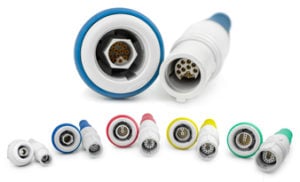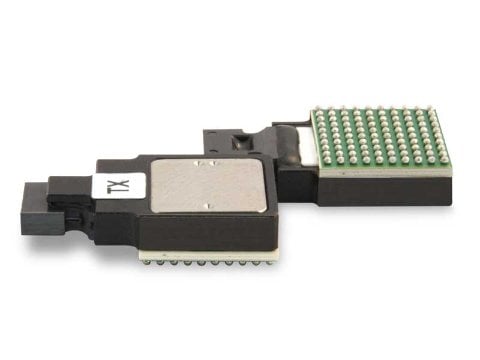- Small: 5.5 mm high (module and interposer)
- Rugged: MIL-STD 883 shock and vibration qualified
- Sealed: Moisture and thermal shock resistant
- Storage temperature: –57 ºC to 100 ºC
- Performance: up to 10.3125 Gbps/channel over a recommended operating temperature range of –40 ºC to 85 ºC
- Sensitivity: –12 dBm or –9 dBm versions available for BER 10–12
- Proven: Used in many defense applications.
- Low power consumption: 100 mW/channel
- 12 TRX (12+12)-lane per device (120G, full duplex)
- Multimode 850 nm wavelength laser
- Over 100 m reach on OM3 ribbon fiber
- Standard MT parallel fiber connector
- RoHS
- Equalizer, pre-emphasis, adjustable output
- Monitoring: LOS, RSSI, temperature, etc.
- Integrated microcontroller
- Attaches to system board with 1 mm LGA interposer
Applications
- Sensor connectivity including all-digital AESA radars
- High I/O density, high BW communication links
- ISR embedded system

Drawing of LightABLE 10G LL 12TRX
Dimensions are given in mm.

Fiber assignment of LightABLE 10G LL 12TRX

1.2 mm, 233 positions Interposer

3.03 mm, 233 positions interposer
Installation of microclip mt ferrule
ETT 2016 -Parallel Optics: The Next Leap for Embed
description can go here
28G Optical Transceivers for Space
Electrical connection with interposers
LightABLE™ and SpaceABLE™ electrical connection with interposers
Electrical connection with interposers
LightABLE™ and SpaceABLE™ electrical connection with interposers
Removal of microclip mt ferrule
ETT 2017 -Lighting the Way for Embedded Systems
Close-up
Optical connection with screw-in connector
Optical connection with MicroClip
Optical connection with MicroClip
ETT 2018 -Scalability and interconnect technologie
ETT 2016 -Parallel Optics: The Next Leap for Embed
description can go here
Optical Interconnect Design Challenges in Space
Optical connection with screw-in connector
Vibration testing of LightABLE rugged transceiver
description can go here
Vibration testing of LightABLE rugged transceiver
description can go here








